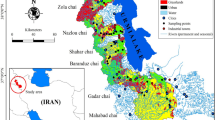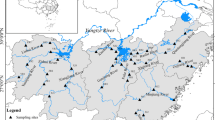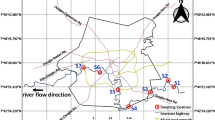Abstract
Heavy metal (HM) pollution is one of the major issues of concern in the world due to its serious health consequences on humans and ecology. In this study, riverine water from the River Kabul in Pakistan was studied using inductively coupled plasma mass spectrometry (ICP-MS) to determine the variation, routes, and possible socio-ecological hazards of chromium (Cr), manganese (Mn), cobalt (Co), nickel (Ni), copper (Cu), zinc (Zn) cadmium (Cd), mercury (Hg), and lead (Pb). The results revealed significant HMs variation (p < 0.05) in the sequence of Cr > Zn > Ni > Cu > Cd > Pb > Mn > Co > Hg, indicating prevalent metal contaminations in the river. Multivariate statistics showed significant strong positive correlations (p ≤ 0.01) between the individual HMs contents along the monitoring sites. The strong-moderate levels of Cu, Co, Zn, Mn, Pb, and Cd in riverine systems were observed to be caused by surrounding industrial, agrochemicals, mining, and domestic wastewater discharges along with geogenic sources, the weak levels of Cr and Ni could be induced by erosion of mafic and ultramafic rocks, and mining activities, whereas the low contamination of Hg suggests minimal atmospheric deposition with fewer industrial discharges in the environment. The overall mass flux of the ∑HMs was estimated to be around 164.10 kg/year, with significant HM pollution index (HPI) and pollution index (PI) variations along the river characterizing the potential risk of HMs in decreasing order of Cd > Hg > Cr > Ni > Co > Pb > Mn > Cu > Zn and Cd > Hg > Ni > Pb > Cr > Co > Cu > Mn > Zn, respectively. Individual HM contamination was within the ecological risk threshold (ERI < 110), where, the chronic daily intake (CDIs), hazard quotients (HQs), health indices (HIs), and cancer risks (CRs) of Cd, Ni, Co, Cr, and Pb by daily riverine water ingestion and dermal contact posing considerable human health concerns. To protect the environment and public health, our findings suggest that untreated anthropogenic wastewater discharge into the river system be strictly controlled and regulated through public awareness campaigns and legislation prohibiting the use of herbicides and fertilizers containing high levels of Cr, Ni, Co, Cd, and Pb.






Similar content being viewed by others
Data Availability
Possible resultant data supporting the findings of this study are accessible in the Supplemental Information, where the additional data that support the findings of this study will be made available upon request from the corresponding author.
References
Aamir, M., Khan, S., Nawab, J., Qamar, Z., & Khan, A. (2016). Tissue distribution of HCH and DDT congeners and human health risk associated with consumption of fish collected from Kabul River, Pakistan. Ecotoxicology and Environmental Safety, 125, 128–134.
Alexakis, D. (2011). Assessment of water quality in the Messolonghi-Etoliko and Neochorio region (West Greece) using hydrochemical and statistical analysis methods. Environmental Monitoring and Assessment, 182, 397–413.
Alexakis, D. (2016). Human health risk assessment associated with Co, Cr, Mn, Ni and V contents in agricultural soils from a Mediterranean site. Archives of Agronomy and Soil Science, 62, 359–373.
Alexakis, D., Gotsis, D., & Giakoumakis, S. (2012). Assessment of drainage water quality in pre-and post-irrigation seasons for supplemental irrigation use. Environmental Monitoring and Assessment, 184, 5051–5063.
Alexakis, D. E. (2020). Meta-evaluation of water quality indices. Application into groundwater resources. Water, 12, 1890.
Alexakis, D. E. (2021). Linking DPSIR model and water quality indices to achieve sustainable development goals in groundwater resources. Hydrology, 8, 90.
Ali, H., & Khan, E. (2018). Assessment of potentially toxic heavy metals and health risk in water, sediments, and different fish species of River Kabul, Pakistan. Human and Ecological Risk Assessment: An International Journal, 24, 2101–2118.
Armah, F. A., & Gyeabour, E. K. (2013). Health risks to children and adults residing in riverine environments where surficial sediments contain metals generated by active gold mining in Ghana. Toxicological Research, 29, 69–79.
Baninla, Y., Zhang, M., Lu, Y., Liang, R., Zhang, Q., Zhou, Y., & Khan, K. (2019). A transitional perspective of global and regional mineral material flows. Resources, Conservation and Recycling, 140, 91–101.
Bhuiyan, M. A., Parvez, L., Islam, M., Dampare, S. B., & Suzuki, S. (2010). Heavy metal pollution of coal mine-affected agricultural soils in the northern part of Bangladesh. Journal of Hazardous Materials, 173, 384–392.
Cao, X., Lu, Y., Wang, C., Zhang, M., Yuan, J., Zhang, A., Song, S., Baninla, Y., Khan, K., & Wang, Y. (2019). Hydrogeochemistry and quality of surface water and groundwater in the drinking water source area of an urbanizing region. Ecotoxicology and Environmental Safety, 186, 109628.
Duan, B., Zhang, W., Zheng, H., Wu, C., Zhang, Q., & Bu, Y. (2017). Comparison of health risk assessments of heavy metals and as in sewage sludge from wastewater treatment plants (WWTPs) for adults and children in the urban district of Taiyuan, China. International Journal of Environmental Research and Public Health, 14, 1194.
Emenike, P. C., Neris, J. B., Tenebe, I. T., Nnaji, C. C., & Jarvis, P. (2020). Estimation of some trace metal pollutants in River Atuwara southwestern Nigeria and spatio-temporal human health risks assessment. Chemosphere, 239, 124770.
Gamvroula, D., Alexakis, D., & Stamatis, G. (2013). Diagnosis of groundwater quality and assessment of contamination sources in the Megara basin (Attica, Greece). Arabian Journal of Geosciences, 6, 2367–2381.
Gao, Q., Li, Y., Cheng, Q., Yu, M., Hu, B., Wang, Z., & Yu, Z. (2016). Analysis and assessment of the nutrients, biochemical indexes and heavy metals in the Three Gorges Reservoir, China, from 2008 to 2013. Water Research, 92, 262–274.
Gotsis, D. (2013). An approximate method for estimating nutrient loads in drainage water from a coastal irrigated area. Earth Sciences Research Journal, 17, 115–118.
Hasanuzzaman, M., Ahammed, G. J., & Nahar, K. (2022). Managing plant production under changing environment. Springer Book.
Herojeet, R., Rishi, M. S., & Kishore, N. (2015). Integrated approach of heavy metal pollution indices and complexity quantification using chemometric models in the Sirsa Basin, Nalagarh valley, Himachal Pradesh, India. Chinese Journal of Geochemistry, 34, 620–633.
Horton, R. K. (1965). An index number system for rating water quality. Journal of Water Pollution Control Federation, 37, 300–306.
Khan, K., Lu, Y., Khan, H., Ishtiaq, M., Khan, S., Waqas, M., Wei, L., & Wang, T. (2013a). Heavy metals in agricultural soils and crops and their health risks in Swat District, northern Pakistan. Food and Chemical Toxicology, 58, 449–458.
Khan, K., Lu, Y., Khan, H., Zakir, S., Khan, S., Khan, A. A., Wei, L., & Wang, T. (2013b). Health risks associated with heavy metals in the drinking water of Swat, northern Pakistan. Journal of Environmental Sciences, 25, 2003–2013.
Khan, K., Khan, H., Lu, Y., Ihsanullah, I., Nawab, J., Khan, S., Shah, N. S., Shamshad, I., & Maryam, A. (2014). Evaluation of toxicological risk of foodstuffs contaminated with heavy metals in Swat, Pakistan. Ecotoxicology and Environmental Safety, 108, 224–232.
Khan, B., Ullah, H., Khan, S., Aamir, M., Khan, A., & Khan, W. (2016). Sources and contamination of heavy metals in sediments of Kabul River: The role of organic matter in metals retention and accumulation. Soil and Sediment Contamination: An International Journal, 25, 891–904.
Khan, K., Lu, Y., Saeed, M. A., Bilal, H., Sher, H., Khan, H., Ali, J., Wang, P., Uwizeyimana, H., & Baninla, Y. (2018). Prevalent fecal contamination in drinking water resources and potential health risks in Swat, Pakistan. Journal of Environmental Sciences, 72, 1–12.
Khan, K., Younas, M., Sharif, H. M. A., Wang, C., Yaseen, M., Cao, X., Zhou, Y., Ibrahim, S. M., Yvette, B., & Lu, Y. (2022a). Heavy metals contamination, potential pathways and risks along the Indus Drainage System of Pakistan. Science of the Total Environment, 809, 151994.
Khan, K., Younas, M., Zhou, Y., Sharif, H. M. A., Li, X., Yaseen, M., Ibrahim, S. M., Baninla, Y., Cao, X., & Lu, Y. (2022b). First report of perfluoroalkyl acids (PFAAs) in the Indus Drainage System: Occurrence, source and environmental risk. Environmental Research, 113113.
Kumar, M., Ramanathan, A., Tripathi, R., Farswan, S., Kumar, D., & Bhattacharya, P. (2017). A study of trace element contamination using multivariate statistical techniques and health risk assessment in groundwater of Chhaprola Industrial Area, Gautam Buddha Nagar, Uttar Pradesh, India. Chemosphere, 166, 135–145.
Malik, J. A. (2022). Advances in bioremediation and phytoremediation for sustainable soil management: Principles, monitoring and remediation. Springer Book.
Nafees, M., Ahmed, T., & Arshad, M. (2011). A Review of Kabul River Uses and Its Impact on Fish and Fishermen. The Journal of Humanities and Social Sciences, 19, 73.
Nawab, J., Khan, S., Ali, S., Sher, H., Rahman, Z., Khan, K., Tang, J., & Ahmad, A. (2016). Health risk assessment of heavy metals and bacterial contamination in drinking water sources: A case study of Malakand Agency, Pakistan. Environmental Monitoring and Assessment, 188, 1–12.
Ngole-Jeme, V. M., & Fantke, P. (2017). Ecological and human health risks associated with abandoned gold mine tailings contaminated soil. PLoS ONE, 12, e0172517.
Onwordi, C. T., Semako, M., Izunobi, J. U., Osifeko, O. L., Majolagbe, A. O., & Ojekale, A. B. (2022). Assessment of the groundwater quality, physicochemical composition, and human and ecological health risks in a coastal metropolitan: A case study of a residential estate in Lagos, Nigeria. Environmental Monitoring and Assessment, 194, 1–19.
Qu, L., Huang, H., Xia, F., Liu, Y., Dahlgren, R. A., Zhang, M., & Mei, K. (2018). Risk analysis of heavy metal concentration in surface waters across the rural-urban interface of the Wen-Rui Tang River, China. Environmental Pollution, 237, 639–649.
Sharifi, Z., Hossaini, S. M., & Renella, G. (2016). Risk assessment for sediment and stream water polluted by heavy metals released by a municipal solid waste composting plant. Journal of Geochemical Exploration, 169, 202–210.
Shomar, B. (2009). Sources and build up of Zn, Cd, Cr and Pb in the sludge of Gaza. Environmental Monitoring and Assessment, 155, 51–62.
Singh, U. K., & Kumar, B. (2017). Pathways of heavy metals contamination and associated human health risk in Ajay River basin, India. Chemosphere, 174, 183–199.
Stamatis, G., Alexakis, D., Gamvroula, D., & Migiros, G. (2011). Groundwater quality assessment in Oropos-Kalamos basin, Attica, Greece. Environmental Earth Sciences, 64, 973–988.
Tchounwou, P. B., Yedjou, C. G., Patlolla, A. K., Sutton, D. J. (2012). Heavy metal toxicity and the environment. Molecular, Clinical and Environmental Toxicology, EXS 101, 133–164.
Thévenot, D. R., Moilleron, R., Lestel, L., Gromaire, M.-C., Rocher, V., Cambier, P., Bonté, P., Colin, J.-L., De Pontevès, C., & Meybeck, M. (2007). Critical budget of metal sources and pathways in the Seine River basin (1994–2003) for Cd, Cr, Cu, Hg, Ni, Pb and Zn. Science of the Total Environment, 375, 180–203.
Turan, V. (2019). Confident performance of chitosan and pistachio shell biochar on reducing Ni bioavailability in soil and plant plus improved the soil enzymatic activities, antioxidant defense system and nutritional quality of lettuce. Ecotoxicology and Environmental Safety, 183, 109594.
Turan, V. (2020). Potential of pistachio shell biochar and dicalcium phosphate combination to reduce Pb speciation in spinach, improved soil enzymatic activities, plant nutritional quality, and antioxidant defense system. Chemosphere, 245, 125611.
Turan, V. (2021). Arbuscular mycorrhizal fungi and pistachio husk biochar combination reduces Ni distribution in mungbean plant and improves plant antioxidants and soil enzymes. Physiologia Plantarum, 173, 418–429.
Turan, V. (2022). Calcite in combination with olive pulp biochar reduces Ni mobility in soil and its distribution in chili plant. International Journal of Phytoremediation, 24, 166–176.
Turan, V., Ramzani, P. M. A., Ali, Q., Abbas, F., Iqbal, M., Irum, A., & Khan, W. U. D. (2018). Alleviation of nickel toxicity and an improvement in zinc bioavailability in sunflower seed with chitosan and biochar application in pH adjusted nickel contaminated soil. Archives of Agronomy and Soil Science, 64, 1053–1067.
Turan, V., Schröder, P., Bilen, S., Insam, H., & Fernández-Delgado Juárez, M. (2019). Co-inoculation effect of Rhizobium and Achillea millefolium L. oil extracts on growth of common bean (Phaseolus vulgaris L.) and soil microbial-chemical properties. Scientific Reports, 9, 1–10.
Ullah, Z., Khan, H., Waseem, A., Mahmood, Q., & Farooq, U. (2013). Water quality assessment of the River Kabul at Peshawar, Pakistan: Industrial and urban wastewater impacts. Journal of Water Chemistry and Technology, 35, 170–176.
ur Rehman, I., Ishaq, M., Ali, L., Khan, S., Ahmad, I., Din, I.U., Ullah, H., (2018). Enrichment, spatial distribution of potential ecological and human health risk assessment via toxic metals in soil and surface water ingestion in the vicinity of Sewakht mines, district Chitral, Northern Pakistan. Ecotoxicology and Environmental Safety 154, 127-136.
Usman, K., Rehman, H. U., Ullah, W., Naseem, M., Babar, M. A., Asif, E., Ayub, M., & Tariq, M. (2019). Heavy metal investigation in River Siranat Khaki site Khyber Pakhtunkhwa Pakistan. Journal of Biodiversity and Environmental Sciences, 14, 97–104.
Uwizeyimana, H., Wang, M., Chen, W., & Khan, K. (2018). Ecotoxicological effects of binary mixtures of siduron and Cd on mRNA expression in the earthworm Eisenia fetida. Science of the Total Environment, 610, 657–665.
Wen, X., Lu, J., Wu, J., Lin, Y., & Luo, Y. (2019). Influence of coastal groundwater salinization on the distribution and risks of heavy metals. Science of the Total Environment, 652, 267–277.
Xu, L., Wang, T., Wang, J., & Lu, A. (2017). Occurrence, speciation and transportation of heavy metals in 9 coastal rivers from watershed of Laizhou Bay, China. Chemosphere, 173, 61–68.
Zhao, Y., Xu, M., Liu, Q., Wang, Z., Zhao, L., & Chen, Y. (2018). Study of heavy metal pollution, ecological risk and source apportionment in the surface water and sediments of the Jiangsu coastal region, China: A case study of the Sheyang Estuary. Marine Pollution Bulletin, 137, 601–609.
Funding
This work was supported by the Researchers Supporting Project number (RSP2023R100), King Saud University, Riyadh, Saudi Arabia. Along with this, this work was also financially supported by the Chinese Academy of Sciences (CAS)-President’s International Fellowship Initiative (PIFI).
Author information
Authors and Affiliations
Contributions
Conception and design of the study: Kifayatullah Khan and Muhammad Younas; acquisition of data: Kifayatullah Khan; analysis and/or interpretation of data: Kifayatullah Khan, Muhammad Younas, Akhtar Zeb Khan, Muhammad Sajawal Khan Sobhy Mostafa Ibrahim, Sana Ullah, Muhammad Ayaz, Afsheen Maryam, Noor Samad Shah, Muhammad Fawad, Xu Li, Jafar Ali, and Asmat Ali; drafting the manuscript: Kifayatullah Khan and Muhammad Younas; revising the manuscript critically for important intellectual content: Muhammad Sajawal Khan, Xu Li, Jafar Ali, Sobhy Mostafa Ibrahim, Afsheen Maryam, Muhammad Fawad, Sana Ullah, Noor Samad Shah, Muhammad Ayaz, Asmat Ali, and Akhtar Zeb Khan; approval of the version of the manuscript to be published: Kifayatullah Khan, Muhammad Younas, Muhammad Sajawal Khan, Xu Li, Muhammad Fawad, Noor Samad Shah, Jafar Ali, Sana Ullah, Muhammad Ayaz, Afsheen Maryam, Asmat Ali, Akhtar Zeb Khan, and Sobhy Mostafa Ibrahim.
Corresponding author
Ethics declarations
Ethics Approval and Consent to Participate
This is an observational study and does not involve any human subjects. The concerned University of Swat Research Ethics Committee has confirmed that no ethical approval is required.
Competing Interests
The authors declare no competing interests.
Additional information
Publisher's Note
Springer Nature remains neutral with regard to jurisdictional claims in published maps and institutional affiliations.
Highlights
• 9-HMs occurrence, routes, and related risks were evaluated in the River Kabul.
• HM contamination and average flow were assessed using pollution indices.
• Anthropogenic effluents and geogenic activities were examined as the potential sources.
• HPI&PI were computed for HMs variation to evaluate the aquatic risk and management.
• CR via river water exposure was significantly high for Cd followed by Ni > Co > Cr > Pb.
Supplementary Information
Below is the link to the electronic supplementary material.
Rights and permissions
Springer Nature or its licensor (e.g. a society or other partner) holds exclusive rights to this article under a publishing agreement with the author(s) or other rightsholder(s); author self-archiving of the accepted manuscript version of this article is solely governed by the terms of such publishing agreement and applicable law.
About this article
Cite this article
Khan, K., Younas, M., Khan, M.S. et al. Heavy Metal Occurrence, Pathways, and Associated Socio-ecological Risks in Riverine Water: Application of Geographic Information System, Multivariate Statistics, and Risk Assessment Models. Water Air Soil Pollut 234, 449 (2023). https://doi.org/10.1007/s11270-023-06427-0
Received:
Accepted:
Published:
DOI: https://doi.org/10.1007/s11270-023-06427-0




